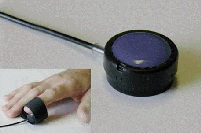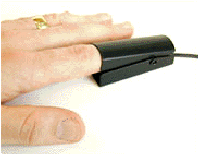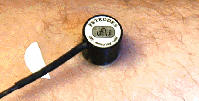Transducers
A 'Transducer'is designed to convert some sort of physical based physiological phenomena into electrical signals that can be amplified and filtered by signal conditioners and bioamplifiers to give meaningful physiological measurements. The physiological phenomenon can be something as simple as a temperature, or a more complex process such as the slight enlargement of tissue resulting from the beating of the heart.
UFI can supply several transducers for the more common human physiometry measures. We can also supply signal conditioning and even ambulatory recorders or data collection systems adapted to these devices. And for a general discussion of how to interface transducers to signal conditioners, please see our Transducer Interfacing Guidelines discussion.
Please note that the transducer prices shown on our price list are for just the transducer. We call this 'bare wire', and we strip and solder tin the lead ends so you can add the connector of your choice. We can also add the appropriate connector for a number of currently used data collection systems, here at our facility. We charge extra for adding the connector and testing the interface. This additional fee is typically $37 for each connector, but can be more. Trust us, some connectors are really expensive!
Model 1010 Piezo-electric Pulse Transducer
The 1010 is a rugged, high-bandwidth (2.5 Hz to 5 kHz) transducer designed to monitor and record peripheral pressure pulses, Korotkoff sounds, carotid pulses, small animal respiratory activity, swallowing, and many other dynamic biological functions (even Heart Sounds!). Strap the 1010 to a subject's finger (see inset picture), and you can easily get Heart Rate from the resulting signal! It's Small size -- 0.95" (23mm) diameter and 0.5" (13mm) thick -- and high output (20-40 millivolts or more) make the 1010 ideal for both teaching and research applications. And since the 1010 is piezo-electric, it does not require an excitation voltage.
Model 1020 Pulse Plethysmograph
The 1020 is a compact, infrared pulse plethysmograph transducer that can be used to record changes in pulsatile blood flow from fingers, toes, ears, the forehead, and other body locations. The 1020 comes in three configurations: the standard 1020, with a flat face and hook-and-loop strap, is ideal for fingers and other extremities; the 1020FC, built into a comfortable clip fixture, is specifically for fingers; and the 1020EC's clip attaches easily to the ear lobe or other thin, loose portions of the skin. Add a 5 to 9 Volt D.C. excitation source, and the 1020 is ready to go.
Model 1030 Force Transducer
The 1030 Physiological Force Transducer is a semi-isometric strain-gauge type that incorporates a stack of five 3" (76mm) stainless steel leaf springs. Four of the leaves can be moved to modify the overall transducer stiffness to meet the sensitivity (10 mg to 1 kg) required for your experiment. A full-bridge configuration provides temperature compensation. The 1030 weighs about 2 ounces (57g) without the 10-foot (3m) cable. An excitation voltage is required.
Model 1040 Physiological Displacement Transducer
The 1040 Physiological Displacement Transducer is a semi-isotonic strain gauge and cantilever-beam device. It uses a 12" x 0.5" x 0.025" (305mm x 13mm x 0.64mm) blade to measure 10 mm to 100 mm motions in many physiological preparations. The nickel-plated steel lever may be placed in any position, offering great flexibility. The 1040 features high linearity and nearly isotonic characteristics. The 1040 weighs about 2 ounces (57g) without the 10-foot (3m) cable. An excitation voltage is required.
Model 1132 Pneumotrace II™
The 1132 Pneumotrace II™ is a piezo-electric respiration transducer that requires no excitation voltage. It generates a substantial (20 to 100 mV) signal in response to changes in thoracic circumference that accompany respiration. With a transducer package 11" long, 1" wide, and 0.125" thick (280mm x 25mm x 3.2mm) linked to the attached 48-inch (122cm) hook-and-loop strap, the 1132 can span a wide range of instrumented diameters. The 1132 can be used not only to measure respiration rate, but also for many studies of respiration volume unless exact measurements are required.
Fetrode™
The Fetrode™ is a transducer of sorts. Right at the electrode, it actually buffers many high impedance, low level bioelectric signals, supplying a very low impedance drive to the signal conditioner. Using Fetrodes can dramatically reduce noise artifacts -- usually due to electrostatic potentials and cable motion -- that can plague bio-electric recordings. The Fetrode can be snapped onto any standard high-quality electrode. Powered by just 500 microamps at 5VDC, Fetrodes measure only 0.575" (15mm) diameter by 0.5" (13mm) thick and weigh 0.2 ounces (6 grams).
Published references to UFI transducers
References to products with individual web pages have links on those pages.






